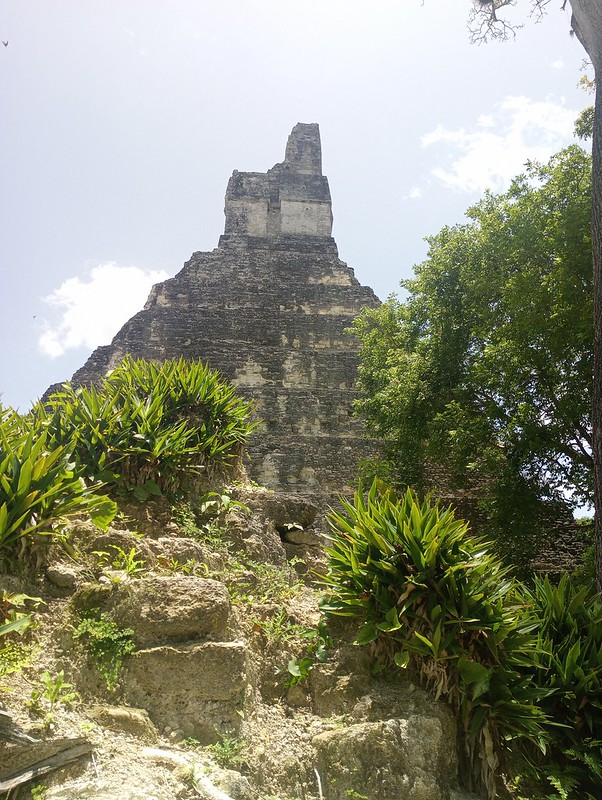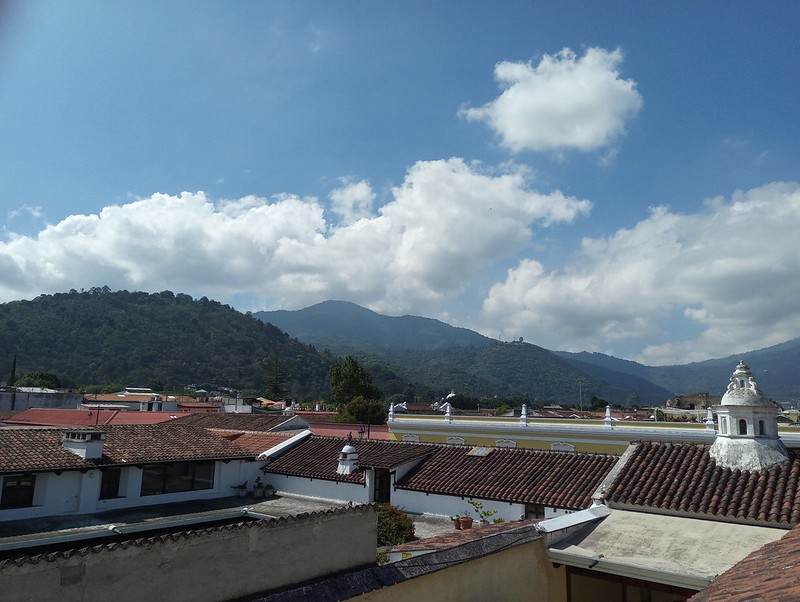The last leg of the program featured some goodbyes to the folks I befriended in Antigua Guatemala, and it featured some last minute places to visit before leaving: desperately wanted some atol (a maize-based hot beverage) from the woman who’s known for making the best atol, a visit to the french-latinx fusion crepe restaurant, a stop at a bakery on the way, and some ice cream (although, for my case, sorbet because of my lactose intolerance). As great as Antigua was, I felt that I’ve done all that there is to do in the city, and so I welcomed the new change of destination my class was embarking through Guatemala and Belize.
At noon, we left Antigua Guatemala and rode in vans to Guatemala City to catch our flight to Flores. Once we landed in Flores, we met the bus that was taking us to the rest of the road trip. This bus was massive, had curtained windows, and there were enough seats that everyone had two of their own. Honestly, that bus was a creature comfort, as it became the one constant in this memorable road trip.
Once we made it to the Tikal National Park and had settled our stuff at our lodge, we hiked into the site of Tikal to witness in-person the scale these ancient Maya cities have and hold. To be honest, I wasn’t too sure what to expect. We had been studying this site (as well as the many others we were going to visit), and yet I felt some kind of anticipation. I had seen the photos of Temples I, II and IV, and I had studied as much as I could about this site and its historical significance to Maya archaeology and history. There was so much to be learned and said back then, and now for me to be there was unimaginable. I never expected that I would ever have the chance to visit this place, yet I did. I was about to witness the architectural legacy and political history of the Tikal dynasty!
Before we saw the picturesque temples that Tikal is renowned for, our professor showed us Maya buildings covered in vegetation and wildlife. It was interesting to see how the jungle swallowed these architectural structures, and it was unimaginable to see the impact plants have on these buildings. Most notable was the extent to which they blended with the forest once the plants had taken over; as if to suggest that there wasn’t anything there. And, if you hadn’t known that the hills here were artificial, you would have mistaken them as just hills. Nevertheless, to see these kinds of structures in person and know that they may remain as they are is curious. I understand the reasoning behind it (funding, research, the need for new kinds of discoveries, etc.), yet I feel that those buildings need to be recognized and shown as they are. To demonstrate to the public how the land they’re visiting didn’t look like the way they imagined it was when discovered.
Ceiba tree in Tikal National Park.
Jungle vegetation around Temple I, Tikal National Park.
After going off the path to see these structures closely and the mini-tarantula scare going back, we walked to Temples I and II, and immediately I felt amazed by the scale of these pyramids. I never realized just how massive these structures were until now. The way they faced each other, as if conversing with one another as tourists walked around unaware of what these temples hold and say about Tikal and its reign. Before them were altars and stelae (tall stone structures, either inscribed or left blank, used as markers) at their bases, another demonstration of the sense of scale and animation Maya cities played with. It was breathtaking to see such histories and legacies in person, and to engage in the intentional space making and design choices made thousands of years ago for the public and court sphere was incredible.
Stelae and altars in front of Temple I, Tikal National Park.
At the Great Plaza, Tikal National Park.
The view from the top of Temple IV, Tikal National Park.
Me at Tikal National Park
Tikal was an incredible site to visit, and I wished there was more time to explore. We had a day in this park, and we had to visit other crucial sites on our trip to Caye Caulker, Belize: Yaxha, Lamanai, to name a few (each impressive in their own right). We had to move on and continue with the rest of the trip; Tikal National Park couldn’t take up the rest of our trip.From there it all just kind of blurs. There was so much planned for this trip — while also making some changes and adjustments after some of my classmates became sick.
One of the more memorable moments of the road trip was when we finally named our bus. We hadn’t given it a name for the first three days, but eventually we named the bus, Zompopo, after the ants we saw and heard about in Tikal. That bus, as I mentioned before, was our only constant, because those who were sick had to take time off the trip to make doctor visits.
Zompopo had been with us through the best and worst times: pulling off incredible fleets through the twisting and turning roads of Guatemalan national parks, acting as a place of rest for us after a long day on our feet, having withstood a dying battery while we waited for it to take us to the next stop, and so many more moments. This bus meant a lot to us, and I’m happy that it was part of the journey. It was the home we needed while engaging in this road trip. We parted ways once we reached to the Caye Caulker water taxi port. Before we left, however, we took a big group photo with Zompopo.
Finally, to end on a farewell note, I spent a good portion of my summer here, and I can’t believe it. Part of me is amazed I was able to get the funds needed to pay for this trip, and part of me is grateful for applying for this study abroad and making the most of it. I’m grateful for the privilege to participate in this trip, and I’m happy to share what I have experienced and learned to my community and home. Most importantly, I’m beyond grateful and appreciative for the support system I have at UT: for helping me through the application process, for the best wishes for the scholarship that made this study abroad so much more accessible to me, and the celebration to be had for someone like me to go and experience this. As I continue to self-reflect and gather more of my thoughts on this incredible program, I’m glad to follow through with this decision and elated to engage in something that I found to be unattainable to me for the longest time. I’m grateful for this experience, and I am excited to share the stories and memories I made, and the knowledge given to me from the course, the people I connected with, and the observations I’ve gathered.
Me at Lamanai Archaeological Site, Belize.


















